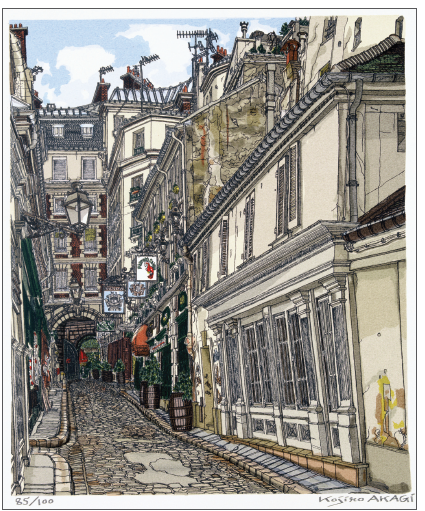La Cour du Commerce Saint-André / Shopping arcade Saint-André / コメルス・サンタンドレ小路
Dublin Core
Title
La Cour du Commerce Saint-André / Shopping arcade Saint-André / コメルス・サンタンドレ小路
Subject
Cour, Commerce Saint-André, Sérigraphie
Description
Il fait bon se promener dans ce petit passage pour piétons qui existe depuis le 18e siècle. C’est le passage typique d’un ancien quartier commerçant. Aujourd’hui, la rue est animée de bars dont certains ont l’allure de pubs anglais. Auparavant c’était un quartier populaire calme. On peut en voir une représentation dans un des chefs-d’oeuvre de Balthus exécutée sur une toile d’environ trois mètres et conservée au Lichtenstein. Dans la boutique à droite du dessin, on peut voir les vestiges des fossés des remparts du château de Philippe Auguste, construit entre 1180 et 1210. Ils ont ensuite été comblés. Une salle de jeu de paume avait été ouverte à cet emplacement. A cette époque, ce jeu était très populaire. On y venait pour voir des joueurs professionnels. En 1776, la rue prend l’aspect qu’elle a aujourd’hui. Des bâtiments pour le commerce y sont construits. La population augmentant, les remparts sont élargis et la ville s’agrandit. Des théâtres voient le jour le long de la rue principale du quartier. En 1686, c’est ici que nait le premier café de Paris qui existe toujours, malgré les changements de propriétaire. On peut le voir derrière les bâtiments à droite du dessin. Ce premier café connait un grand succès, car le café était rare, très recherché et valait l’équivalent d’un esclave.
This is an alley too narrow for cars. It existed since the 18th century and retains the atmosphere of an old shopping area. People love to walk along this alley. Though nowadays this street is full of British-style pubs and taverns, in the past it was a quiet cobblestone street which Balthus painted on an almost three-meter-long canvas, a masterpiece owned by the Principality of Liechtenstein.On the wall of the shop in the left side of the picture, the remnants of the Enceinte de Philippe Auguste (constructed from 1180 to 1210) which can be seen still now, so we can see that it was at the bottom of the outer moat at one time. It was reclaimed and turned into a venue for playing jeu de paume which was like a combination of tennis and badminton before they became separate sports. There were professional players already at that time, people were prepared to pay to watch them play. In 1776 it morphed into the street as it is now and the buildings of the shopping district were built. The population increased and the castle walls were expanded, thus the town got bigger: theatres appeared in the main street, Paris’ first café opened in 1686 and some are being run by different owners to this day. The building to be seen on the right side of this picture is the back of this café. It was very popular at that time. Coffee was so valuable that the price of a cup of coffee equalled the price of a slave.
車の入らない細い路地。十八世紀からあって、昔の商店街の趣きの残っている、散歩コースとして愛される道である。今は英国風パブだとか、飲み屋小路みたいな具合だが、以前はバルチュスの大作で、リヒテンシュタイン公国に所蔵される、三メートル近いよく知られた絵にも描かれた、静かな石畳の裏町だった。絵の左側の商店の、店の中の壁には、フィリップ・オーギュストの城壁(一一八〇年~一二一〇年に掛けて建設)の遺構が残っていて、今でも見えるのだから、外堀の底だったのが分かる。埋め立てられて、テニスとバトミントンが分かれる前の一緒になったジュー・ド・ポーム遊びの、球戯場だったが、その頃にもうプロ選手がいて、お金とって見せるほどの人気ゲームだった。一七七六年現在残っている道路になり、商店街の建物も建てられたのだが、人口が増えて城壁を広げ、町が広がって、表通りの方に劇場が出来たり、パリで始めてのカッフェが一八八六年に出来て、今でもオーナーは変わってもそのまま続いている店まであるが、その店の裏側がこの絵の右手である。カッフェの第一号店、当時大人気だったのである。コーヒー一杯分の値段が、奴隷の一人分というような、貴重な飲み物だったらしい。
Creator
Kojiro Akagi (1934-2021)
Date
Août 1990 / August 1990
Rights
Fonds de dotation Kojiro AKAGI
Format
Sérigraphie, Atelier Del Arco, 100 tirages + 14 E.A. romain,
sur papier Arches 49,5 x 65 cm.
sur papier Arches 49,5 x 65 cm.
Type
Sérigraphie
Citation
Kojiro Akagi (1934-2021), “La Cour du Commerce Saint-André / Shopping arcade Saint-André / コメルス・サンタンドレ小路,” Kojiro Akagi - Fonds de dotation Kojiro AKAGI , accessed December 21, 2025, https://kojiroakagi.com/gallery/items/show/94.

